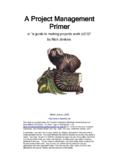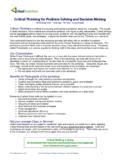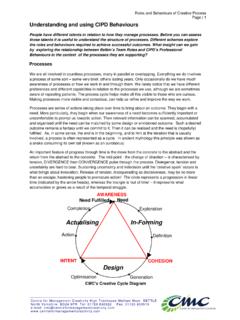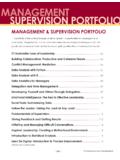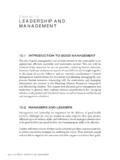Transcription of PISA 2012 Problem Solving Framework - OECD.org
1 PISA 2012 FIELD TRIAL Problem Solving Framework DRAFT SUBJECT TO POSSIBLE REVISION AFTER THE FIELD TRIAL Consortium: Australian Council for Educational Research (ACER, Australia) cApStAn Linguistic Quality Control (Belgium) Deutsches Institut f r Interup to nationale P dagogische Forschung (DIPF, Germany) Educational Testing Services (ETS, USA) Institutt for L rerutdanning og Skoleutvikling (ILS, Norway) Leibniz - Institute for Science Education (IPN, Germany) National Institute for Educational Policy Research (NIER, Japan) The Tao Initiative: CRP - Henri Tudor and Universit de Luxembourg - EMACS (Luxembourg) Unit d'analyse des syst mes et des pratiques d'enseignement (aSPe, Belgium) Westat (USA) Doc: ProbSolvFrmwrk_FT2012 30 September 2010 3 Framework lem Solving for PISA 2012 Prob30 September 2010 TABLE OF CONTENTS PREAMBLE.
2 5 Chapter 1: INTRODUCTION .. 7 Problem Solving in PIAAC .. 9 Chapter 2: DEFINING THE DOMAIN .. 11 Scope of the Assessment .. 15 Chapter 3: ORGANISING THE DOMAIN .. 16 a. Problem Context .. 16 b. Nature of Problem Situation .. 17 Interactive Problem Situations .. 18 Static Problem Situations .. 19 Ill defined Problems .. 19 c. Problem Solving Processes .. 19 Reasoning Skills .. 21 Chapter 4: ASSESSING Problem Solving COMPETENCY .. 23 a. Structure of the Assessment .. 23 Functionality Provided by Computer Delivery .. 23 b. Task Characteristics and Difficulty .. 24 Response Formats and Coding .. 25 Interactive Problems .. 26 c. Distribution of Items .. 27 Chapter 5: REPORTING Problem Solving COMPETENCY.
3 29 Chapter 6: SAMPLE TASKS .. 30 REFERENCES .. 31 ANNEX A: OVERVIEW OF Problem Solving RESEARCH .. 35 Historical and Theoretical Foundations .. 35 Early Conceptions .. 35 Associationism .. 35 Gestalt Psychology .. 36 George Polya .. 36 Information Processing .. 37 Current Lines of Research on Problem Solving .. 37 Decision Making .. 37 Reasoning .. 39 Intelligence and Creativity .. 39 Teaching of Thinking Skills .. 40 Expert Problem Solving .. 40 Thinking by Analogy .. 41 Mathematical and Scientific Problem Solving .. 41 Situated Cognition .. 42 Cognitive Neuroscience of Problem Solving .. 42 Complex Problem Solving .. 43 Conclusions .. 44 References .. 46 4 ANNEX B: Problem Solving EXPERT GROUP.
4 49 5 Framework lem Solving for PISA 2012 Prob30 September 2010 PREAMBLE 1. This document presents the recommended Framework for assessment of Problem Solving in the PISA 2012 field trial. The Framework will be fine tuned for the main survey following consideration of the outcomes of the field trial, and sample items from the field trial will be included as additional examples. The following paragraphs describe the development of the Framework to this stage. 2. A first draft of the Problem Solving Framework was considered at the first Problem Solving Expert Group (PEG) meeting held in Melbourne from 10 12 February 2010. A second draft was prepared by Consortium staff immediately following the PEG meeting for presentation to the National Project Managers meeting held in Hong Kong from 1 5 March.
5 Feedback received at the Hong Kong NPM meeting, together with extensive written feedback from PEG members, was used to prepare a third draft intended for consideration at the PISA Governing Board meeting which was to be held in Copenhagen from 19 21 April 2010. 3. With the grounding of European flights due to volcanic ash cloud, the Copenhagen meeting was cancelled and replaced with a written consultation on issues that were to be settled at the meeting. As a consequence, comments from PGB members on the Problem Solving Framework were not available when the fourth draft was prepared for consideration at the PEG meeting held in Boston from 21 23 June 2010. However, the fourth draft did incorporate feedback on the third draft from PEG members and test developers.
6 Only a small number of changes were made to the previous draft but some comments relating to unresolved matters, and to new issues raised by PEG members, were included for discussion in Boston. 4. Feedback from PGB members on the fourth draft was considered by the PEG at its Boston meeting, along with recommendations from the PISA Strategic Development Group (SDG) presented by Eugene Owen. Following the PEG meeting, Consortium staff prepared a fifth draft reflecting decisions made in response to the PGB and SDG feedback and the comments contained in the fourth draft. This fifth draft was circulated to PEG members for review and their feedback was incorporated in the version submitted to the OECD at the start of August.
7 The present version incorporates changes agreed to at the PEG meeting held in Budapest from 27 29 September. 7 CHAPTER 1: INTRODUCTION 1. Problem Solving competency is a central objective within the educational programmes of many countries. The acquisition of increased levels of Problem Solving competency provides a basis for future learning, for effective participation in society and for conducting personal activities. Students need to be able to apply what they have learned to new situations. The study of individuals Problem Solving strengths provides a window on their capabilities to employ basic thinking and other general cognitive approaches to confronting challenges in life (Lesh & Zawojewski, 2007).
8 2. Problem Solving was an additional assessment domain in PISA 2003. Some key findings of the survey were as follows (OECD, 2004): In some countries 70% of students could solve relatively complex problems, while in others less than 5% could do so. In most countries, more than 10% of students were unable to solve basic problems. On average in OECD countries, half of the students were unable to solve problems that are more difficult than basic problems. Patterns of within country variation in students Problem Solving proficiency differed considerably across countries. Patterns of within country differences between Problem Solving proficiency and domain related proficiencies (mathematics, reading, science), differed considerably across countries.
9 3. Since the 2003 Problem Solving assessment Framework (OECD, 2003a) was developed, considerable research has been carried out in the areas of complex Problem Solving , transfer, computer based assessment of Problem Solving , and large scale assessment of Problem Solving competency ( Blech & Funke, 2005; Funke & Frensch, 2007; Greiff & Funke, 2008; Klieme, 2004; Klieme, Leutner, & Wirth, 2005; Leutner, Klieme, Meyer, & Wirth, 2004; Mayer, 2002; Mayer & Wittrock, 2006; O Neil, 2002; Osman, 2010; Reeff, Zabal & Blech, 2006; Wirth & Klieme, 2004). This research has led to advances in understanding and measuring individuals Problem Solving capabilities. 8 4. In addition, advances in software development tools and the use of networked computers have made possible greater efficiency and effectiveness of assessment, including the capability to administer dynamic and interactive problems, engage students interest more fully and capture more information about the course of the Problem Solving process.
10 On this last point, computer delivery of assessment tasks makes it possible to record data about such things as the type, frequency, length and sequence of actions performed by students in responding to items. 5. It is appropriate, therefore, to once again make Problem Solving an assessment domain in PISA, but in doing so to devise a new Framework and implement additional assessment methodologies that allow for the real time capture of students capabilities. In particular, the PISA 2012 assessment of Problem Solving will be computer based and interactivity of the student with the Problem will be a central component of the information gathered. 6. PISA 2012 Problem Solving is an assessment of individual Problem Solving competency.











